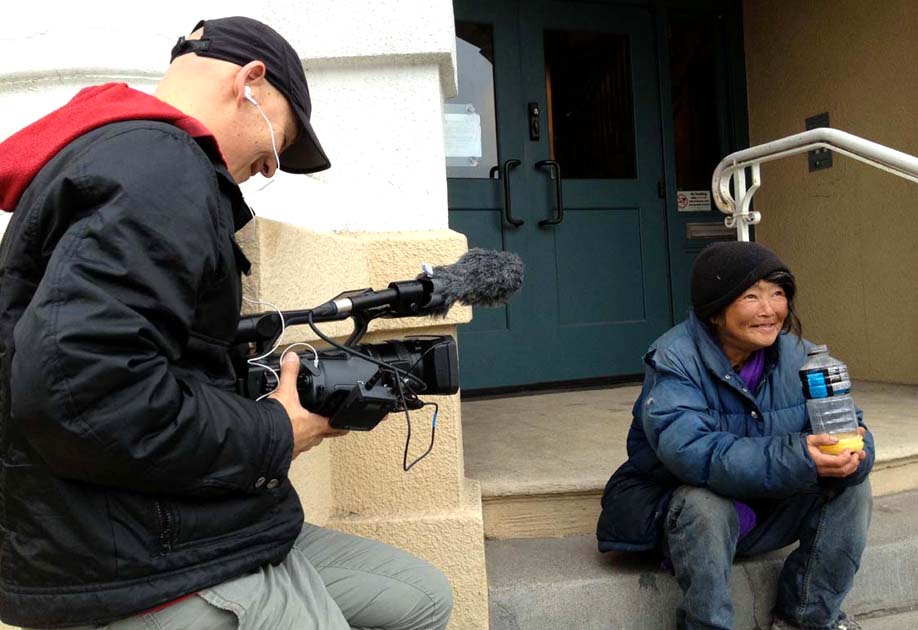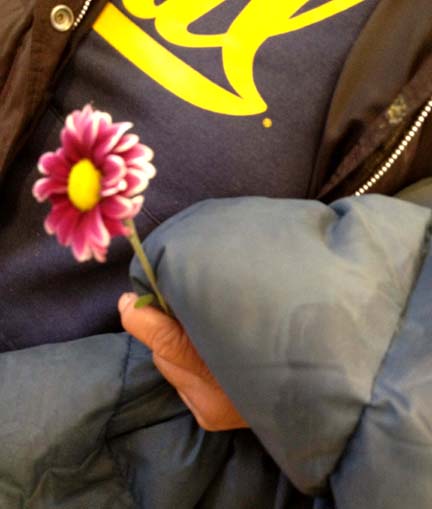
by Zachary Stickney
[dropcap]L[/dropcap]ast December, I wrote an article for the Street Spirit, a local newspaper on homelessness, about Miss Hayok Kay, a homeless shopping cart recycler and the empress of the forthcoming documentary film, “Dogtown Redemption.” The article was well-received, and triggered a roller coaster of wonderful and difficult news in the months that followed. [See “Stories of Recycling and Redemption on the Street,” Street Spirit, December 2012.]
Shortly after the article was published, I was contacted by a social service worker at St. Mary’s Center in Oakland. She was moved by Miss Kay’s story and offered to review her case and explore her staying at the shelter. To our collective delight, Miss Kay was approved to stay at St. Mary’s after only a few short interviews.
For us, this was a major breakthrough, if only for the fact that we could rest knowing Miss Kay was somewhere safe and warm for the night. But more important, she was eager to go to St. Mary’s, and even worked on small volunteer projects for the center. Better still, the shelter allowed Miss Kay to retain her freedom, and offered myriad opportunities for personal growth, healing, and community.
One such event was a memorial held at St. Mary’s Center that eulogized homeless individuals who had died on the street in previous years. Those who attended were each given a single flower — a symbol of the memory of those they had lost. At the end of the service, dozens gathered in a circle, saying the names of those they had lost while tossing their flower into the center of the circle. The chorus chimed: “Beloved, we are here.”
Miss Kay dedicated her flower to her beloved — the artist Fred Griffing. But as she shouted his name, other attendees had sounded tributes to their own beloveds, and Hayok’s tiny voice was drowned out.
As the event came to a close and the others left, Miss Kay remained in her chair crying. As the memories of her love flooded back, Miss Kay was again reminded of her history of impermanence — how, more often than not, the things she cherishes most are torn from her. How previous loves, old friends, and even her own family had removed themselves from her life. How her years on the street had made her almost invisible — a shadow of a life in transit between this world and the next.
Only a few feet away, my first reaction was to rush in and hug her. To tell her she was still loved. To remind her that she was still worth something, that her and Fred’s story was worth something, and that we, at the very least, would never forget. But I stayed myself — she was on camera. A rush to hug her would ruin an otherwise intimate shot. Funny, how in that moment, the very tool we used to tell her story was the same one that made her untouchable.
Filming done, the moment passed. I hugged her anyway, even though we both knew it was less genuine than it would have been even a few seconds earlier. She offered a practiced smile that said, “I’m okay, really” — more for my sake than hers, I thought. The day’s work done, we left together to eat lunch and catch up.
Not long after that day, another bout of depression and drinking took the better of Miss Kay, and she was unable to continue her stay at St. Mary’s. The fact that the worst of the winter was over was only a small reprise. An all-too-familiar question hung over us all: What now?

The truth is plainly that we don’t know. As filmmakers and as friends, we do our best to help in what ways we can while remaining true to the story we are telling. Through these roller coasters, we’ve learned tremendously about extreme poverty and homelessness. We’ve seen what works and what doesn’t, and the many gray areas in between.
Still, at the end of the day, we are not necessarily the ones who will have all the answers. What we can offer, however, is some insight into the holes in our systems, and work to encourage dialogue and action in mending them. These wounds are not the recyclers’ or ours to bear alone — they are community wounds, and it will take a community to heal them.
This is our redemption, and why I believe so strongly in the message of “Dogtown Redemption.” Recyclers like Miss Kay are not voiceless — they have only lacked a conduit to make their voices heard. We are not their voices. We are merely letting them speak.
But we need your support to bring the film to a close. Our deadline to finish is mid-September, in time to apply for the 2014 Sundance Film Festival — an opportunity to bring the conversation on poverty to a national audience.
To help us reach our goal, we have launched a Kickstarter campaign to help us raise the funds necessary to finish the film. The biggest hurdle here is postproduction — editing over 200 hours of footage into an 80-minute feature.
Over the years, we have received grants from the Sundance Documentary Film Fund, Cal Humanities, and others, and the gracious support of many friends. We just need one more push to get across the finish line — to shatter the stereotypes of the poor, and bring a five-year marathon to a successful conclusion. We can’t do this without you, and so we put our film and our faith in your hands.
_______________________________
Please contribute to “Dogtown Redemption”
Please help us make poverty visible.
Your donation can make all the difference in the world. Please contact:
redemptiondocumentary@gmail.com
To learn more, visit the film’s website at www.redemptiondoc.org
